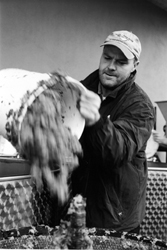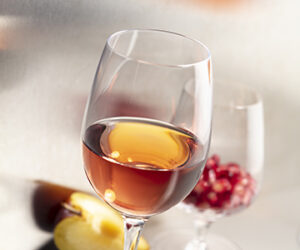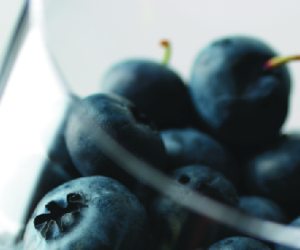Dominic Rivard is a consultant fruit winemaker producing commercial wines in Asia, North America and Europe and author of “The Ultimate Fruit Winemaker’s Guide” at www.fruitwineguide.com. A qualified sommelier, Dominic studied winemaking and oenology at UC-Davis and passed the Wine and Spirit Education Trust (WSET) Diploma with distinctions.
I would say that choosing a yeast strain for a specific style of fruit wine is very important. Yeast is a major key in differentiating a good wine and a truly great, award-winning wine.
I experiment a fair amount with different strains of yeast and over the years I have narrowed my wine production to the following strains:
Lallemand 71B: This is a great all around yeast for most off-dry fruit wines. It really helps bring out the fresh fruitiness in most berry and some tree fruit wines.
Lallemand BA11: This strain is excellent on tree fruit and tropical fruit wines. It really helps develop the aroma and can increase mouthfeel.
Lallemand EC1118: A good all around yeast, especially with wines with low pH or starting the ferment at low temperatures. If you need the fruit wine to ferment to a very dry level, or to make a sparkling wine, this is the yeast to use.
Lallemand ICV-K1: Great at bringing out freshness in tree fruit wines such as apple or peach. It will ferment well, no matter what the pH or temperature of the must is. I use this strain the most.
Lallemand R2: A very good, strong strain, ideal for very sweet fruit wines, cryo-extrated wines and wines that need to ferment at low temperatures to retain the aromatic qualities. I use this yeast in “iced” fruit wines with a lot of success.
Lallemand VIN13: I use this yeast in wines that need higher alcohol without fortification as it can ferment to almost 17% without any help. It gives good tropical notes and relatively clear flavors and can ferment under cooler temperatures.
Bio Springer CKS 102: I also frequently use this strain if I need aromatic berry wines such as raspberry or delicate strawberry wines to really shine. Also works great on tropical wines such as lychee, pineapple and passion fruit. In fruit wines, we want as clean a ferment as possible and this strain does a good job at it.
Oenoferm Freddo: I have just started to use this yeast strain recently and I am very happy with the results. I find that it brings out the fresh fruit aroma that I look for many of the wine styles I produce.
The effects that different yeast strains have on particular wines are varied, but as far as fruit wines are concerned I am a strong believer that these wines need to have a strong, clean and fresh aromatic quality to them. Because fruit wines usually have a lower nitrogen content to them and can be a bit hard on yeast, I look for strains that work well in lower nutrient content and accentuate fresh aromatic qualities under less than ideal conditions.
The main method of experimentation is by doing smaller scale bench trials before deciding on a yeast strain to use and making larger quantities of wine with it. The easiest way to experiment with different strains is to split a particular batch of wine into two, three or four smaller batches and inoculate each with different yeast strains. After a wine is fermented, fined and filtered, the wines are then evaluated on a standard 20-point judging system (color, aroma, taste and finish), very often it is done in wine competitions. Obviously the winner indicated which yeast strain produced a better wine. It is amazing how obviously different the wines can be!
Most professional winemakers don’t give a thought to using a different wine yeast strain with their wines. The biggest problem that many home winemakers have is the lack of knowledge on the effect of using different yeasts on different types of wines. Don’t just choose “Champagne” yeast for everything.
Another major issue is that you should not just sprinkle the dry yeast on the surface of the must. Sure, the wine may still ferment but you are much more prone to developing a stuck or sluggish fermentation, which will create off flavors and take away from the fruity aromas you need in a fruit wine. Rehydrate the yeast well. This is one area where you do not want to skip corners.
When choosing a yeast for fruit wines, go for the strain that can work well under low temperature, pH and nutrient levels and more importantly accentuate aromatic qualities of the fruit. Sometimes yeasts are only available in 500 g or even 1 kg packages, which can be a lot of yeast if you are making smaller amounts of wine. Getting together with other winemakers or joining a winemaking club is a great way to pool resources and buy some of these yeast strains to share.

Choosing a fruit wine yeast is very important — that’s one of the starting points for any wine. Yeast strains impart some very different characteristics on the wine. I’ve done a lot of different experiments with yeast and the differences are amazing. The ultimate starting point is the fruit, but the yeast is the first step the winemaker does to steer the wine in a certain direction.
We use yeasts primarily from Lallemand (Lalvin) that we get through Scott Laboratories. My number one, go-to strain is EC1118 (Prise De Mousse), which is good because it performs in a fairly harsh environment and in cooler temperatures. With EC1118, you have to be sure you have high enough nutrient levels. If you don’t have the proper nutrient levels you can run into H2S problems. K1 (V1116) will start up at lower temperatures and can handle high alcohol — up to 18%. I use K1 specifically for stuck ferments. 71B is a strain that is used for developing fruit qualities and softens really high acid wines like black currant, raspberry and crabapples. It seems to soften the acid and brings out nice delicate fruit flavors.
We also make some sparkling wines and I’m just getting into using ProElif, which is a double-encapsulated yeast that is added directly to the bottle to initiate bottle fermentation. The cool thing about these little beads is that you don’t need to riddle the wine — they sink to the bottom of the bottle because the capsules have more density. It saves a lot of heartache, although if your alcohol SO2 levels are too high they struggle. I add them at 15ppm and shoot for a base wine around 9% ABV.
Two other strains I like are F33, because it works in low nitrogen or nutrient environments and has a pretty good alcohol tolerance, and R2, which does very well at cold temperatures. If you can’t get your ambient temperature up, R2 yeast gets in there and gets working, but you need to give it a fair amount of nutrients. It produces intense, direct fruity and floral notes and brings the fruit characters out.
If you’re trying to find the right yeasts at home, experiment with a couple of strains that you think would work well. Get all the information on each strain and figure out what limitations they have, then work within the parameters of the strain — some yeasts simply don’t work in certain environments. Also, if you can, know your free sulfur — some strains really don’t like it and will make some really ugly byproducts because of it. Try the same fruit base wine with two different yeasts and identify the benefits and attributes of the yeast. We experimented a lot like this when we started the winery to originally find the best strains of fruits but ended up finding out a lot about yeasts as well.





